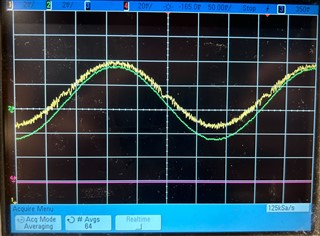Other Parts Discussed in Thread: ISO224, ,
Tool/software:
Hello,
I am experimenting with the AMC3302 (and ISO224) for isolated current sensing in a power electronics control application. We notice that at low frequencies (<10Hz) there is a significant distortion that appears to be 0 crossing distortion present in the amplified signal. I was wondering if 1. This is expected in these isolated amplifiers 2. Is there something that can be done to minimize the distortion in these units.
Here is a captured waveform with the input (green) and output (yellow) for the ISO224 where the distortion is visible.

Thanks.


